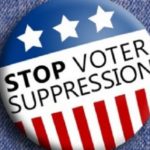 Earlier this week, Bloomberg had a fairly revealing article about the internal digital efforts of the Donald Trump campaign, in which Bloomberg reporters embedded for a few days. The whole article is quite interesting, but one of the most stunning parts, frankly, was the Trump campaign staffers directly admitting how they are actively trying to suppress voting by African Americans. It’s no secret that a variety of new voter ID laws are designed to suppress voting — especially among minorities. When North Carolina’s voter ID law was struck down by the court, the judge pointed out how the legislators that had backed it had explicitly targeted rules that would suppress votes among African Americans. They had requested “racial data” concerning voter ID and then specifically targeted the types of ID more commonly used by African Americans.
Earlier this week, Bloomberg had a fairly revealing article about the internal digital efforts of the Donald Trump campaign, in which Bloomberg reporters embedded for a few days. The whole article is quite interesting, but one of the most stunning parts, frankly, was the Trump campaign staffers directly admitting how they are actively trying to suppress voting by African Americans. It’s no secret that a variety of new voter ID laws are designed to suppress voting — especially among minorities. When North Carolina’s voter ID law was struck down by the court, the judge pointed out how the legislators that had backed it had explicitly targeted rules that would suppress votes among African Americans. They had requested “racial data” concerning voter ID and then specifically targeted the types of ID more commonly used by African Americans.
Each of these new rules disproportionately impacted black voters seeking to exercise the franchise, as legislators in North Carolina were well aware. “Prior to enactment” of the law, the Fourth Circuit explained, “the legislature requested and received racial data as to usage of the practices changed by the proposed law.” Released from the obligation to clear their law with the Justice department and “with race data in hand, the legislature amended the bill to exclude many of the alternative photo IDs used by African Americans.” Photo IDs used more often by black voters, including public assistance IDs, were removed from the list of acceptable identification, while IDs issued by the Department of Motor Vehicles—which blacks are less likely to have—were retained. Cutting the first week of early voting came in reaction to data showing that the first seven days were used by large numbers of black voters, nixing one Sunday on which churches would bus “souls-to-the-polls”. Banning same-day registration, too, had an outsize effect on blacks, as did the prohibition on out-of-precinct voting: both changes made voting harder for people who had recently moved, and blacks are more itinerant than whites.
That, alone, was pretty stunning, but they still tried to pretend in public that the law wasn’t about suppressing the vote. However, when put with a Bloomberg reporter, the Trump campaign flat out brags about its efforts to suppress the vote among African Americans. And they’re using extreme targeting on Facebook to do so:
Instead of expanding the electorate, Bannon and his team are trying to shrink it. “We have three major voter suppression operations under way,” says a senior official. They’re aimed at three groups Clinton needs to win overwhelmingly: idealistic white liberals, young women, and African Americans. Trump’s invocation at the debate of Clinton’s WikiLeaks e-mails and support for the Trans-Pacific Partnership was designed to turn off Sanders supporters. The parade of women who say they were sexually assaulted by Bill Clinton and harassed or threatened by Hillary is meant to undermine her appeal to young women. And her 1996 suggestion that some African American males are “super predators” is the basis of a below-the-radar effort to discourage infrequent black voters from showing up at the polls—particularly in Florida.
On Oct. 24, Trump’s team began placing spots on select African American radio stations. In San Antonio, a young staffer showed off a South Park-style animation he’d created of Clinton delivering the “super predator” line (using audio from her original 1996 sound bite), as cartoon text popped up around her: “Hillary Thinks African Americans are Super Predators.” The animation will be delivered to certain African American voters through Facebook “dark posts”—nonpublic posts whose viewership the campaign controls so that, as Parscale puts it, “only the people we want to see it, see it.” The aim is to depress Clinton’s vote total. “We know because we’ve modeled this,” says the official. “It will dramatically affect her ability to turn these people out.”
Now that’s… interesting (and ridiculous, but we’ll leave that aside for the moment). Of course, every election cycle involves a ton of targeted “negative advertising” that is designed to suppress overall interest in a candidate. But the two things newsworthy here are (1) the fact that the Trump campaign is directly admitting to the intention behind that strategy here, rather than hiding it and (2) the ability to use Facebook to target these kinds of campaigns to a level previously not available.
Facebook, somewhat famously, allows extraordinarily targeted advertising. We’ve played around with it ourselves, and it’s really quite incredible how granular you can go in trying to target your ads. Basically any trait or interest or demographic group that you can think of, you can put into an ad target group. At times, as you dig through the options, it almost feels like it’s just Facebook showing off just how much data and insight it has into its users. It’s a data nerd’s dream, where you can slice and dice billions of people by basically anything.
